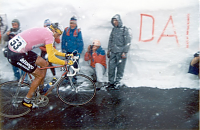Bicycle Graphic Design

Well this site contains a few cycling graphics that should please every cycling fan.
Source
Why Bicycles Don't Tip

“Simple Explanation Of The Principles Of Balanced Involved
Riding That Is Easy and Riding That Is Difficult – The Steering of the Wheel from Side to Side Keeps It Under the Centre of Gravity of the Body – What Speed Has to Do With it – Facts of Interest to All Wheelmen.”“ When bicycles first came into use, the general impression was that the task of balancing them could only be acquired after weeks of patient and persevering practice. This is not true; nevertheless, it would not be reasonable to form any other conclusion if guided wholly by appearance, for certainly when one sees a rider coming along the road, the wonder is, how can he manage to keep in an upright position with so little apparent effort. It is probable that there are very few persons who have not at some time or other tried to settle in their own minds this question, and, judging from the general impression that prevails among those who do not know how to ride, the conclusions arrived at are in most cases erroneous. Almost every one believes that it is easier to balance the wheel when running slow than when going at a high rate of speed, but this is just the reverse of the facts, as every rider well knows. The most difficult thing to do on a bicycle is to stand still. The next most difficult thing is to move along at the slowest possible speed. Any novice can ride at a ten or twelve mile per hour velocity, but he who can go at one mile rate is an expert.
As a matter of fact, the art of balancing a bicycle is not difficult to acquire, and now when nearly every one rides this fact has become very well known. Why a feat that looks so difficult should be so easy has puzzled many a mind, and any number of attempts to solve the problem have been made, but in almost every case the theories developed have been incorrect, either wholly or in part. The most common notion that prevails in relation to the subject is that the headway, as it is generally expressed, or, more properly speaking, the momentum, keeps the wheel from falling over. This supposition is only partially true; the velocity only assists in maintaining a balance, and this is the reason why it is easier to ride fast than slow. But this very fact, that speed simplifies the act of balancing, has led almost every one to believe that it is the only cause upon which the action depends.
The real reason why a bicycle can be balanced so easily is that the wheel can be steered from side to side; and thus be kept under the centre of gravity of the body. If the wheel could not be turned to one side or the other, but was confined to a straight line, the balance could only be maintained by throwing the body from side to side, so as to keep the centre of gravity over the wheel, and this would be far more difficult to accomplish. To illustrate this point, consider the case of a man trying to balance himself upon the heels of his shoes. He will soon feel that his weight is going either forward or back-ward, and to avoid falling over he will take a few short steps in the direction in which his body is moving, and thus restore the equilibrium. So long as he keeps moving his heels, one way or the other, he will have no difficulty In preserving his balance; but if he tries to accomplish the same result without moving his heels he will find that he can only maintain a balance for a few seconds, and to accompliRh even that much he will have to swing his body and arms around in anything but a graceful manner. This explains why it is so much easier to maintain a balance on stilts than on a tight rope. One would naturally suppose that the latter would be the easier, because the whole length of the foot rests upon the rope, and, therefore, only the tendency to fall over sidewise has to be counteracted; while with the stilts, as they terminate in very small ends, the body can tip in any direction. But the stilt walker can balance himself without difficulty, because no matter in what direction he may incline he can keep the stilts under the body by simply stepping in that direction. >>eXc
» Read moreChasing Annie

One Monday in late June 1894, a slight, unprepossessing woman in her early 20s climbed onto a Columbia bicycle in front of the Massachusetts State House in Boston. Annie Cohen Kopchovsky was 5- foot-3, about 100 pounds. Aside from two quick lessons in the previous days she had never ridden a bicycle in her life. All across the country, women who’d never balanced atop two wheels were taking to bicycles, but not merely for recreation or transport. Women used bikes as vehicles of political and social change, too. The women’s suffrage movement and the cycling craze went hand in hand. On two wheels, women found independence and freedom of movement. Because pedaling in billowing Victorian skirts and corsets was impractical, for instance, female cyclists popularized bloomers. To critics, these changes symbolized moral corruption.
Frances Willard, one of the most famous women of the times, was a leading suffragist and president of the Women’s Christian Temperance Union, then the largest women’s political organization. She learned to ride at 53, and mastery of the bicycle as a metaphor for women’s mastery over their lives was the message of her 1895 book, A Wheel Within a Wheel: How I Learned to Ride the Bicycle (reprinted in 1997 by Applewood Books). She wrote that she rode “from a love of acquiring this new implement of power and literally putting it underfoot.” Indeed, fellow suffragist Susan B. Anthony said in 1896 that the bicycle “has done more to emancipate women than anything else in the world.”
From Peter Zheutlin’s article in Bicycling magazine:
Source












